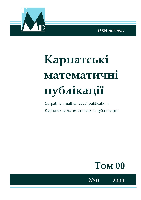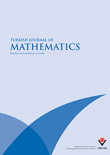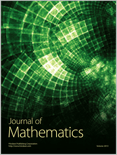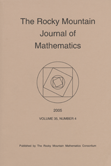
Journal of Analysis
Scope & Guideline
Fostering Innovation in Mathematics
Introduction
Aims and Scopes
- Fractional Calculus and Differential Equations:
The journal publishes research on fractional calculus, including fractional differential equations and their applications in various fields such as physics, engineering, and biology. - Fixed Point Theory:
A significant portion of the journal's content is dedicated to fixed point theorems, exploring various mappings and their properties in different types of metric and topological spaces. - Functional Analysis and Operator Theory:
Research articles often delve into functional analysis, with a focus on operators, their properties, and applications in both pure and applied mathematics. - Approximation Theory:
The journal includes studies on approximation methods, particularly those involving special functions and polynomials, contributing to the development of numerical methods. - Metric Spaces and Topology:
Exploration of various types of metric spaces, their properties, and the implications for analysis and topology is a recurring theme, highlighting the interplay between these areas. - Stochastic Processes and Applications:
The journal also covers stochastic models and their mathematical analysis, particularly in the context of epidemic models and other real-world applications.
Trending and Emerging
- Fractional Order Models:
The journal has seen an increase in publications related to fractional order models, particularly in contexts such as ecology and epidemiology, highlighting their relevance in modeling complex systems. - Stochastic Analysis:
Research on stochastic processes, particularly in relation to epidemic modeling and other real-world applications, is gaining traction, indicating a growing interest in probabilistic methods. - Numerical Methods and Computational Analysis:
There is a notable trend towards the development and analysis of numerical methods, especially those that address complex differential equations and integral equations. - Complex Analysis and Special Functions:
Emerging works in complex analysis, particularly those involving meromorphic functions and their properties, reflect a renewed interest in the intricate relationships between analysis and complex variables. - Graph Theory and Network Analysis:
An increasing focus on graph theory and its applications in various fields, including biology and social sciences, is becoming more prominent in the journal's publications.
Declining or Waning
- Traditional Real Analysis:
There has been a noticeable decline in papers focusing on classical topics in real analysis, as the journal shifts towards more applied and interdisciplinary approaches. - Basic Inequalities and Elementary Functions:
Research on simple inequalities and elementary function properties has decreased, suggesting a move towards more complex and sophisticated mathematical frameworks. - Elementary Number Theory:
Papers in elementary number theory have become less frequent, possibly due to the increased focus on higher-dimensional and more abstract areas of mathematics.
Similar Journals

Carpathian Mathematical Publications
Pioneering Open Access to Mathematical Excellence.Carpathian Mathematical Publications, published by Vasyl Stefanyk Precarpathian National University, stands as a significant contribution to the field of mathematics, particularly highlighted by its Q2 ranking in Mathematics (miscellaneous) for 2023. With an ISSN of 2075-9827 and E-ISSN of 2313-0210, this Open Access journal, initiated in 2009, enables researchers and practitioners worldwide to freely access cutting-edge mathematical research, thus promoting knowledge sharing and collaboration. Based in Ivano-Frankivsk, Ukraine, the journal focuses on a broad spectrum of mathematical topics while fostering innovative approaches and interdisciplinary connections within the mathematical community. Its current Scopus ranking of rank #122 out of 399 reflects its growing influence and importance, making it an ideal platform for scholars and students aiming to advance their research and stay abreast of the latest developments in general mathematics.

Bulletin of Mathematical Analysis and Applications
Cultivating a Hub for Mathematical InnovationBulletin of Mathematical Analysis and Applications is a distinguished academic journal published by UNIV PRISTINA, DEPT MATHEMATICS COMPUTER SCIENCES, located in the vibrant city of Prishtina, Kosovo. This journal is dedicated to the dissemination of groundbreaking research in the fields of Mathematical Analysis and Applied Mathematics, focusing on both theoretical and practical aspects of these disciplines. While currently categorized in the Q4 quartile for analysis, applied mathematics, and miscellaneous mathematics, the journal is on an upward trajectory, welcoming contributions from researchers and professionals who strive to advance the frontiers of mathematical knowledge. Though its Open Access status is still to be developed, the journal remains committed to fostering a scholarly environment that promotes collaboration and innovation. With convergence years set from 2019 to 2024, the Bulletin of Mathematical Analysis and Applications aims to be an essential resource for those pursuing advancements in mathematics, providing a platform for new ideas and methodologies to flourish.

Rendiconti del Circolo Matematico di Palermo
Fostering Scholarly Dialogue Across Mathematical Disciplines.Rendiconti del Circolo Matematico di Palermo, published by SPRINGER-VERLAG ITALIA SRL, is a revered journal in the field of mathematics, emphasizing the cultivation and dissemination of mathematical knowledge since its inception in 1887. With its ISSN 0009-725X and E-ISSN 1973-4409, this esteemed publication has continued to thrive, showcasing innovative research, comprehensive reviews, and thoughtful discussions from diverse areas in mathematics, particularly in its Q2 ranking within the miscellaneous mathematics category. Its historical significance is underscored by its convergence of publications across numerous years, including its notable periods from 1887 to 1916, 1919 to 1938, and beyond, effectively capturing the evolution of mathematical thought. Though not open access, the journal remains an essential resource for researchers, professionals, and students aiming to stay updated with the latest advancements and methodologies in the ever-evolving landscape of mathematics. With its Scopus rank placing it in the top 25th percentile, Rendiconti del Circolo Matematico di Palermo continues to be a cornerstone for scholarly dialogue and development in its domain.

Turkish Journal of Mathematics
Pioneering Insights in the World of MathematicsTurkish Journal of Mathematics is a prestigious academic publication dedicated to the advancement of mathematical research across a variety of subfields. Established in 1995 and published by the Tubitak Scientific & Technological Research Council Turkey, this journal has built a solid reputation, especially noted for its significant contributions to the field over the years, with its convergence spanning from 1995 to 2002 and again from 2006 to 2024. The journal, which holds a commendable Q2 ranking in Mathematics (miscellaneous) and is positioned in the 66th percentile of Scopus rankings for General Mathematics, aims to disseminate high-quality original research, reviews, and innovative methodologies to advance both theoretical and applied mathematics. Researchers, professionals, and students alike will find invaluable resources within its pages, providing insights that are pivotal for academic and practical applications in mathematics. Although it does not currently offer open access options, the journal remains an essential platform for those looking to engage with the forefront of mathematical inquiry.

Advanced Studies-Euro-Tbilisi Mathematical Journal
Shaping the Future of Mathematics from TbilisiAdvanced Studies-Euro-Tbilisi Mathematical Journal, published by the esteemed TBILISI CENTRE MATH SCI, is a vital resource for scholars and practitioners in the field of mathematics. Since its inception in 2021, this journal has committed to advancing knowledge across various mathematical disciplines, including Algebra and Number Theory, Analysis, Applied Mathematics, and Geometry and Topology, although it currently holds a category quartile ranking of Q4 in all these areas. With an open-access format, it provides unparalleled access to cutting-edge research to a global audience of researchers, professionals, and students, fostering collaboration and innovation within the mathematical community. Operating from TBILISI, Georgia, the journal acknowledges the growing importance of diverse geographical contributions to mathematics and aims to spotlight emerging research trends. As research continues to evolve, Advanced Studies-Euro-Tbilisi Mathematical Journal seeks to enrich the academic dialogue and support the dissemination of mathematical knowledge.

Carpathian Journal of Mathematics
Navigating the Frontiers of Mathematical ScienceCarpathian Journal of Mathematics, published by NORTH UNIV BAIA MARE in Romania, is an esteemed research platform dedicated to the diverse and evolving field of mathematics. With an impressive Q2 ranking in the 2023 Mathematics (miscellaneous) category, this journal serves as a vital resource for researchers and practitioners alike, offering insights into both theoretical and applied mathematics. Spanning from its inception in 2003 to the anticipated contributions in 2024, it has established itself as a reputable source with a significant impact, reflected in its Scopus rank of #84/399 in General Mathematics, positioning it in the 79th percentile. Although it operates without open access, the journal ensures that subscribers, institutions, and readers enjoy rigorous peer-reviewed content that pushes the boundaries of mathematical inquiry. From algebra and number theory to applied mathematics and mathematical modeling, the Carpathian Journal of Mathematics stands as a beacon for innovation and scholarly dialogue, catering to an audience eager to contribute to and learn from the mathematical sciences.

Journal of Mathematics
Exploring the depths of mathematical innovation.Welcome to the Journal of Mathematics, a premier open access journal published by Hindawi Ltd, dedicated to advancing knowledge in the diverse realm of mathematics. Since its inception in 2013, the journal has provided a platform for the dissemination of significant mathematical research and applications, achieving recognition in the 80th percentile of the general mathematics category as per Scopus rankings. With a commitment to fostering academic collaboration and accessibility, the journal promotes critical dialogue among researchers, professionals, and students alike. Located in the vibrant academic hub of London, England, the Journal of Mathematics continues to enhance its impact within the mathematical community, as evidenced by its Q3 classification in mathematics (miscellaneous) for 2023. Join us in exploring groundbreaking research and innovations, as we converge towards the future of mathematical sciences through our open access model.

Hacettepe Journal of Mathematics and Statistics
Bridging Theory and Application in Mathematical ResearchHacettepe Journal of Mathematics and Statistics, published by Hacettepe University in Turkey, is a vital platform for scholars in the fields of mathematics and statistics. With a commitment to promoting rigorous research, this journal covers a diverse range of topics including Algebra and Number Theory, Analysis, Geometry and Topology, and Statistics and Probability. Since its inception in 2008 and looking forward to its continued convergence up until 2024, it has established itself as a resource for both theoretical and applied mathematics. Although it currently holds a Q4 ranking in Algebra and Number Theory and Q3 in multiple other categories, its commitment to quality research is evident through its Scopus rankings, positioning it favorably among its peers. The journal operates on an open access model, facilitating wide dissemination of knowledge, and is particularly appealing to researchers, professionals, and students aiming to stay at the forefront of mathematical sciences. With an E-ISSN of 2651-477X, the Hacettepe Journal of Mathematics and Statistics aspires to foster collaboration and innovation in the mathematical community.

Mediterranean Journal of Mathematics
Empowering the Next Generation of MathematiciansThe Mediterranean Journal of Mathematics, published by SPRINGER BASEL AG, is a prominent platform dedicated to the advancement of mathematical research and education. Since its inception in 2004, this journal has been pivotal in disseminating high-quality research across various fields of mathematics, currently holding a notable Q2 ranking in the miscellaneous mathematics category as of 2023. With its ISSN 1660-5446 and E-ISSN 1660-5454, the journal enjoys a respected position in the academic community, evident by its Scopus rank of 129 out of 399 in General Mathematics, placing it in the 67th percentile. While primarily a subscription-based journal, it remains committed to providing a comprehensive resource for researchers, professionals, and students, fostering dialogue and exploration within the mathematical sciences. The Mediterranean Journal of Mathematics, based in Basel, Switzerland, continues to contribute significantly to the evolution of mathematical theory and practice, marking its relevance as we approach its 20th anniversary in 2024.

ROCKY MOUNTAIN JOURNAL OF MATHEMATICS
Elevating Mathematical Discourse Since 1971ROCKY MOUNTAIN JOURNAL OF MATHEMATICS, published by the Rocky Mountain Math Consortium, serves as a critical platform for researchers and practitioners in the field of mathematics since its inception in 1971. With a notable presence in the academic community, this journal covers a broad spectrum of mathematical disciplines, positioning itself in the Q2 category for Mathematics (miscellaneous) as of 2023. Despite being a subscription-based journal, it is recognized for its rigorous peer-review process and contributions to theoretical and applied mathematics, helping to advance knowledge and foster collaboration among mathematicians. The journal's ISSN number is 0035-7596 and its E-ISSN is 1945-3795, reflecting its commitment to accessibility and dissemination of high-quality research. Based in Tempe, Arizona, at Arizona State University, the journal continues to play an important role in shaping contemporary mathematical discourse through well-researched articles and innovative studies, aiming to bridge gaps between various mathematical subfields and engage a diverse audience, including students and established researchers alike.